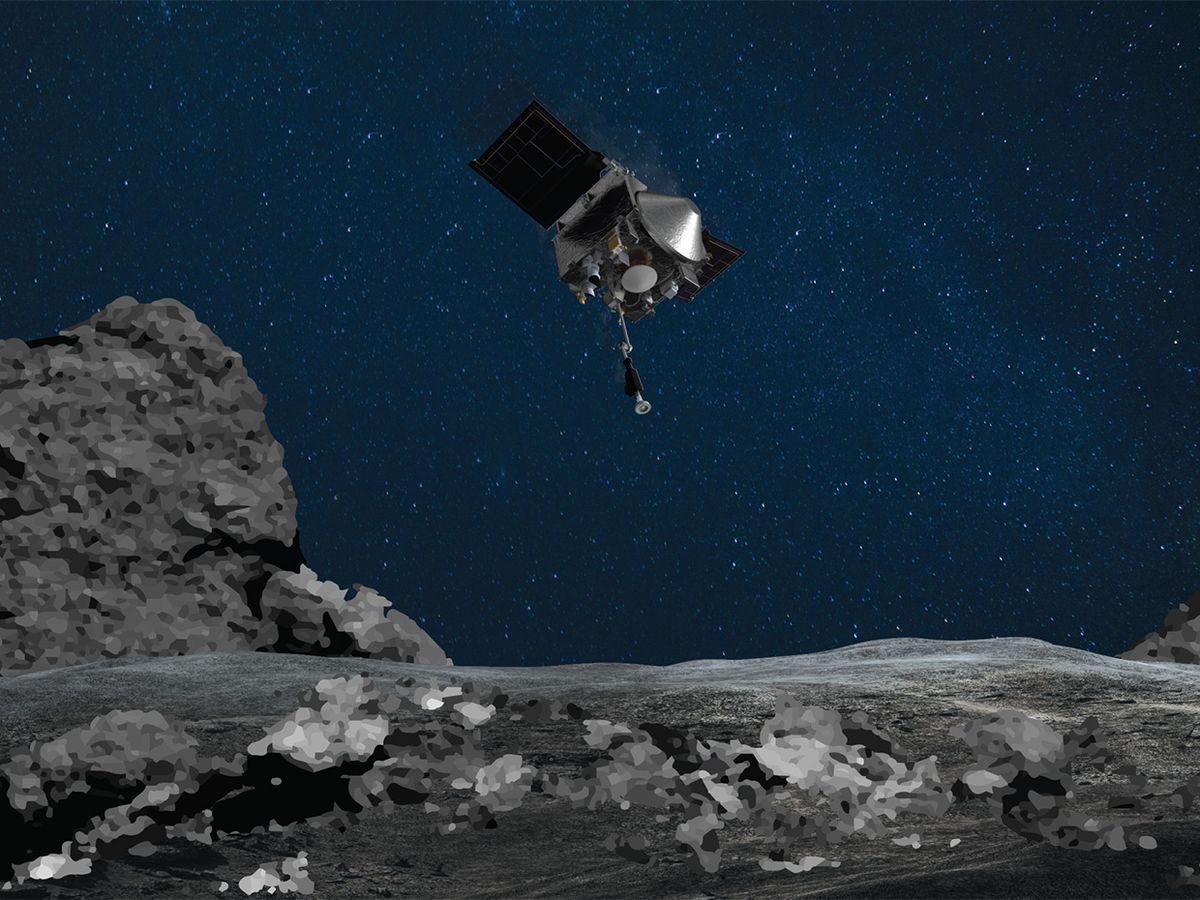It’s a good thing robotic spacecraft are not sentient, because if they were, they would probably hate us. Their reward for a job well done has usually been abandonment. We build them, send them far into space, record the data they send back, and then, because there’s usually no realistic way to recover them, we leave them to the abyss.
NASA’s OSIRIS-REx asteroid-sampling probe is one of the rare exceptions. On May 10, if everything works, it will start on its way home. No, NASA hasn’t had a change of philosophy, and OSIRIS-REx itself will never land on Earth. But sealed inside a re-entry capsule on its instrument deck is a tiny sample of rock and dirt from the surface of the asteroid 101955 Bennu, and scientists are waiting for it. It is a precious cache: Bennu is believed to be made of carbon-rich debris from the early ages of the solar system.
“Bennu is a time capsule,” said Thomas Zurbuchen, Associate Administrator for the Science Mission Directorate at NASA. “It’s been out there for four and a half billion years waiting for us.”

OSIRIS-REx, launched in 2016, has been orbiting and mapping Bennu since 2018, and in October it descended to the asteroid’s surface to grab some of its soil. Today, six months later, the ship is virtually on the opposite side of the sun from Earth—an optimal time for it to fire its main engines for a trip that should allow it to drop its sample capsule in the Utah desert, 80 km west of Salt Lake City, on September 24, 2023.
That’s in more than two years, even though Bennu’s orbit is relatively close to Earth’s. There are many reasons for taking it slow. Fuel must be conserved, the ship’s cargo is priceless, and the laws of orbital mechanics are unforgiving.
“I would call it a moderate risk maneuver,” says Peter Antreasian, the navigation team chief. “It’s high-consequence—mission failure if the maneuver doesn’t go off. But we’ve been doing, oh, gosh, 120 maneuvers so far and we haven’t had a problem yet.”
OSIRIS-REx has been a success so far—but Bennu, a ball of rubble less than 500 meters across, has thrown one surprise after another at mission managers. They never tried to land on the asteroid for the soil sampling; “landing” on a body whose gravity is only 8 one-millionths of Earth’s would never work. Instead, the ship descended to one of the few relatively smooth spots it could find on the surface and jabbed it gently with a drum-shaped collection chamber at the end of a 3-meter arm. To their surprise, the probe seemed to break through the rock. They had hoped for at least 60 grams of soil (a sample that would easily fit in the palm of your hand), but realized the collector was so full that pieces of asteroid debris were escaping from it. They hurried to seal the collector in the return capsule for the ride home. They don’t know what they have – they decided to skip a planned measurement – but one guess is that the capsule is carrying 300 grams.
The return plan, says Antreasian, begins with a seven-minute engine burn that should increase the spacecraft velocity, relative to the sun, by about 950 kilometers per hour. Right now Bennu is 89 percent as far from the sun as Earth is, but to rendezvous with Earth, the spacecraft will have to follow an ellipse that takes it 40 percent farther out—almost as far from the sun as Mars is. Confirmation of the engine burn should come at about 4:16 p.m. EDT Monday, but if it doesn’t happen, there are several more opportunities through June.

Orbital maneuvering is paradoxical: A spacecraft accelerates to reach a higher orbit, but actually takes longer to complete that orbit. It is almost as if OSIRIS-REx were being shot out in a big arc so that Earth can move into place beneath it.
For safety’s sake, the ship’s planned trajectory would miss the Earth by 10,000 km; a midcourse burn in September 2022 should reduce that to 2,500 km, with later maneuvers to close the gap even more. The sample return capsule—a blunt cone like other re-entry spacecraft dating back to the Apollo Command Module—would detach and go tearing into the atmosphere at 12.2 km/sec, slowed by the thickening air around it and then by parachute.
Recovery teams will be at the ready to track the capsule down after it lands, and then take it to the Johnson Space Center in Texas to be opened in a sealed, specialized laboratory. Small as the soil sample is likely to be, there should be enough to share with other countries, and some would be stored for decades so that future scientists with better instruments and greater knowledge can study it.
And as for the main OSIRIS-REx spacecraft? After it releases the re-entry capsule, it will fire its engines again—just enough to go whipping around the Earth, headed toward the inner solar system. If technology and funding allow, it may actually have another mission after Bennu, a reconnaissance of another target in space.
After that, there is no getting around it. Its fuel stores depleted, its electronics degraded by cosmic radiation and extreme temperatures, OSIRIS-REx will probably end up like its brethren: left by its makers to wander the solar system, perhaps forever.
UPDATE, May 10, 2021: NASA confirms that its OSIRIS-REx spacecraft successfully fired its engines to begin the two-year trip from asteroid 101955 Bennu to Earth. The seven-minute engine burn was completed at 4:23 p.m. EDT. Expected arrival date: September 24, 2023.
Ned Potter is a New York writer who spent more than 25 years as an ABC News and CBS News correspondent covering science, technology, space, and the environment.



